A Fault Direction Criterion Based on Post-Fault Positive-Sequence Information for Inverter Interfaced Distributed Generators Multi-Point Grid-Connected System
Abstract
1. Introduction
2. Analysis of Output Characteristics of IIDG with Low-Voltage Ride-Through Capability
3. Analysis of the Applicability of Conventional Directional Elements
4. A Fault Direction Criterion Based on Post-Fault Positive-Sequence Components
4.1. Change in Positive-Sequence Impedance Angle after Grid Failure
4.2. Fault Direction Criterion Based on the Positive-Sequence Impedance Phase
- (1)
- When any phase current measured by a directional element is greater than twice the maximum load current, the directional element starts.
- (2)
- Collect the data of three-phase steady-state voltage and current within the time window tw after t starting from system failure, and calculate the positive-sequence voltage and current, where t = 20 ms and tw = 20 ms. Among them, the current data must be the three-phase current flowing from the directional element to the protected line.
- (3)
- If the recorded positive-sequence voltage meets , the voltage data from 20 ms before the fault are utilized for calculation, avoiding voltage dead zone issues in case of a three-phase short circuit at the line outlet.
- (4)
- Calculate the phase difference of the positive-sequence voltage and current, denoted as .
- (5)
- Compare with the threshold of direction criterion, and if Equation (12) is satisfied, it is judged as a positive direction fault; if Equation (13) is satisfied, it is determined to be a reverse direction fault.
5. Case Analysis
5.1. Penetration Rate of the Downstream IIDGs Is 120%
5.2. Penetration Rate of the Downstream IIDGs Is 150%
6. Conclusions
- (1)
- The strong coupling nonlinear relationship between the output current of IIDG and the PCC voltage may lead to misjudgments of the directional elements based on 90° wiring and the positive-sequence fault components.
- (2)
- The proposed direction criterion is a general criterion formed by extracting the post-fault positive-sequence components in the scenario of an IIDG multi-point grid-connected network considering a low-voltage ride-through strategy. It is suitable for fault direction discrimination when different short circuit faults occur at any position and is not affected by the prefault power flow. The direction criterion does not need to be adjusted when the system operation mode changes.
- (3)
- The direction criterion can avoid misjudgment through the design of the start threshold when the system load is too large and the IIDG capacity is small, and can eliminate the dead zone using the prefault voltage phase, without affecting the direction discrimination result. It has a large margin, and can still operate correctly when the IIDG penetration is high and there is a short circuit through transition resistance.
Author Contributions
Funding
Data Availability Statement
Conflicts of Interest
References
- Zhu, L.; Li, C.; Zhang, H.; Zhou, P.Y. Directional overcurrent protection for distribution systems containing distributed generation. Power Syst. Technol. 2009, 33, 94–98. [Google Scholar]
- Wei, M.; Wang, C.; Yu, Y.; Liang, Y.; Wang, X. Optimal configuration scheme of multi-staged protection in distribution network for integration of high proportion of distributed photovoltaic. Autom. Electr. Power Syst. 2023, 47, 55–65. [Google Scholar]
- Miao, X.; Zhao, D.; Liu, X.; Hong, C.; Zhuang, S. A Research review of short-circuit protection in distribution network with distributed generation. High Volt. Eng. 2023, 49, 3006–3019. [Google Scholar]
- Wang, B.; Chen, H. Overview study on improving protection methods of distribution network with distributed generation. Power Syst. Prot. Control. 2017, 45, 146–154. [Google Scholar]
- Yan, J.; Xia, S.; Wang, F. Analysis of new criterion for pilot direction of distribution network with distributed generations. Proc. CSU-EPSA 2018, 30, 112–117. [Google Scholar]
- Zhou, C.; Zou, G.; Du, X.; Yang, J. A pilot protection method based on positive sequence fault component current for active distribution networks. Proc. CSEE 2020, 40, 2102–2112+2390. [Google Scholar]
- Zhang, X.; Cao, R. Solar Photovoltaic Grid-Connected Power Generation and its Inverter Control, 3rd ed.; China Machine Press: Beijing, China, 2018; pp. 300–301. [Google Scholar]
- Kong, X.; Zhang, Z.; Yin, X.; Wang, F.; He, M. Study on fault current characteristics and fault analysis method of power grid with inverter interfaced distributed generation. Proc. CSEE 2013, 33, 65–74+13. [Google Scholar]
- Dai, Z.; Yu, L.; He, J.; Zhang, Y. Improvement strategy of local feeder automation for IIDG integration. Electr. Power Autom. Equip. 2023, 43, 184–191. [Google Scholar]
- Li, Y.; Jia, K.; Bi, T.; Yan, R.; Chen, R.; Yang, Q. Influence mechanism of inverter interfaced renewable energy generators on fault component based directional relay. Power Syst. Technol. 2017, 41, 3230–3236. [Google Scholar]
- Rao, C.; Shao, W.; Xia, J. Research on the directional component using the current phase characteristics in distribution system. J. Xian’an Polytech. Univ. 2017, 31, 781–787. [Google Scholar]
- Liu, K.; Li, Y. Study on Solutions for Active Distribution Grid Protection. Proc. CSEE 2014, 34, 2584–2590. [Google Scholar]
- Lin, X.; Lu, Y.; Wang, L. New current protection scheme considering distributed generation impact. Autom. Electr. Power Syst. 2008, 32, 50–56. [Google Scholar]
- Si, X.; Chen, Q.; Gao, Z.; Ma, J.; Chen, M.; Wang, L. Protection scheme for active distribution system based on directions of current phase angle variation. Autom. Electr. Power Syst. 2014, 38, 97–103. [Google Scholar]
- Li, Z.; Ye, S.; Wang, Q. Directional element of current for active distribution network. High Volt. Appar. 2018, 54, 199–204. [Google Scholar]
- Zhu, Y.; Zhao, H.; Chen, Z. Fault direction discriminating element used for the distribution network with IIG integration. Electr. Power 2019, 52, 76–82. [Google Scholar]
- Jalilian, A.; Hagh, M.T.; Hashemi, S.M. An innovative directional relaying scheme based onpostfault current. IEEE Trans. Power Deliv. 2014, 29, 2640–2647. [Google Scholar] [CrossRef]
- Mishra, P.; Pradhan, A.K.; Bajpai, P. Time-domain directional relaying using only fault current for distribution system with PV plant. IEEE Trans. Power Deliv. 2022, 37, 2867–2874. [Google Scholar] [CrossRef]
- Zhang, H.; Li, Y.; Chen, X.; Niu, W. New criteria of directional component in distribution network with photovoltaic generator of low voltage ride through capability. Autom. Electr. Power Syst. 2015, 39, 106–112. [Google Scholar]
- Jiao, Y.; Liang, X.; Jiang, C. Directional element action area calculation considering LVRT of grid-connected PV plant. Electr. Power Autom. Equip. 2017, 37, 20–24. [Google Scholar]
- Technical Rule for Connecting Photovoltaic Power Station to Power Grid: Q/GDW1617-2015. Available online: http://www.doc88.com/p-33773164675858.html (accessed on 18 June 2024).
- He, J.; Li, T.; Dong, X.; Li, B.; He, J. Primciples of Relay Protection of Electric Power System; China Electric Power Press: Beijing, China, 2018; pp. 56–58. [Google Scholar]
- Xu, B.; Li, T.; Xue, Y. Relayig Protection and Automation of Distribution Networks; China Electric Power Press: Beijing, China, 2017; pp. 114–116. [Google Scholar]
- Chen, H.; Pan, X.; Huang, H.; Sun, X.; He, D.; Yong, C. Equivalent modeling of LVRT and current limiting links for distributed photovoltaic and wind turbine generators. Electr. Power Autom. Equip. 2022, 42, 25–32+39. [Google Scholar]
- Math, B.; Fainan, H. Integration of Distributed Generation in the Power System; China Machine Press: Beijing, China, 2015; pp. 255–267. [Google Scholar]
- Li, Z.; Xu, Y.; Wang, P.; Xiao, G. Restoration of a multi-energy distribution systems with joint district network recon figuration by a distributed stochastic programming approach. IEEE Trans. Smart Grid 2024, 15, 2667–2680. [Google Scholar] [CrossRef]





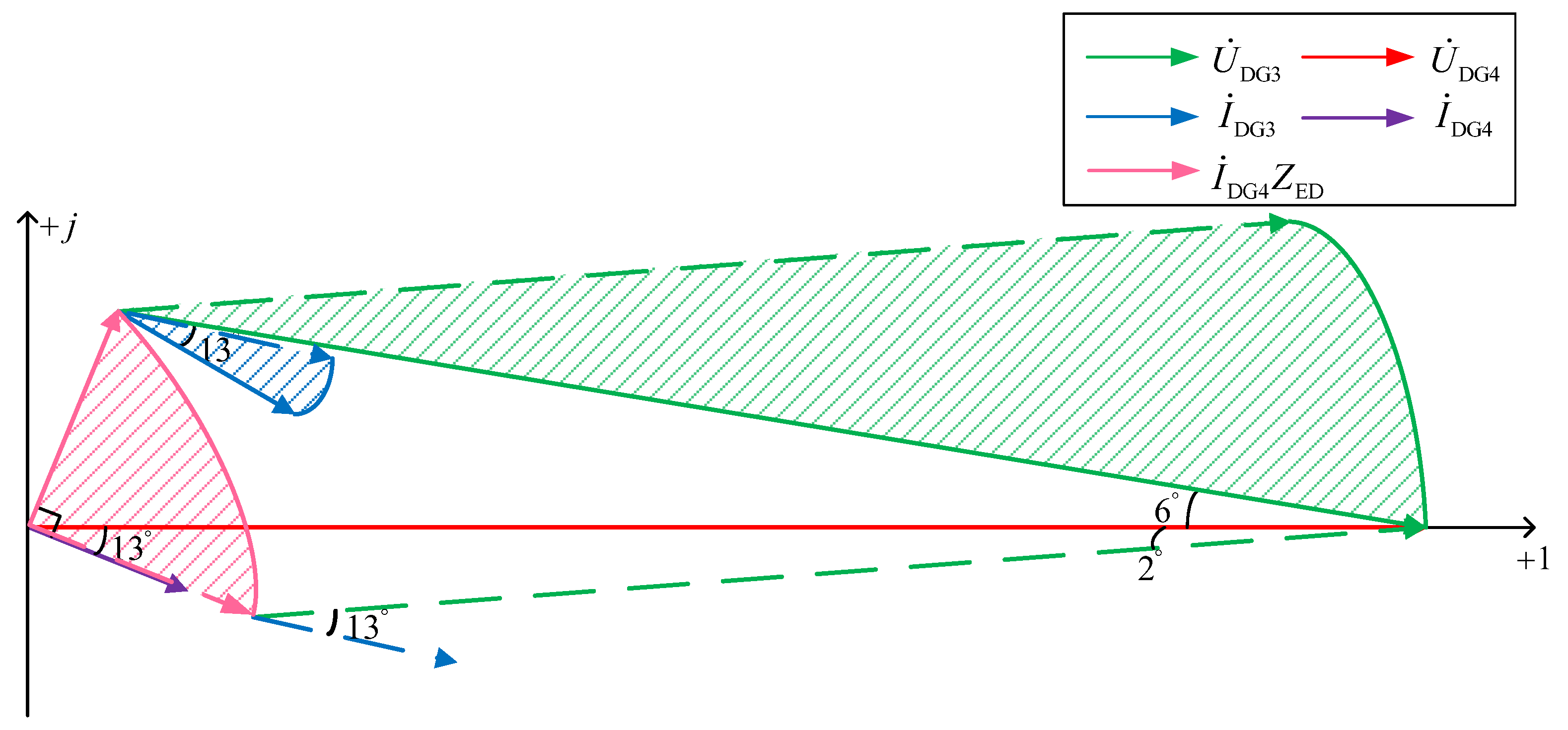

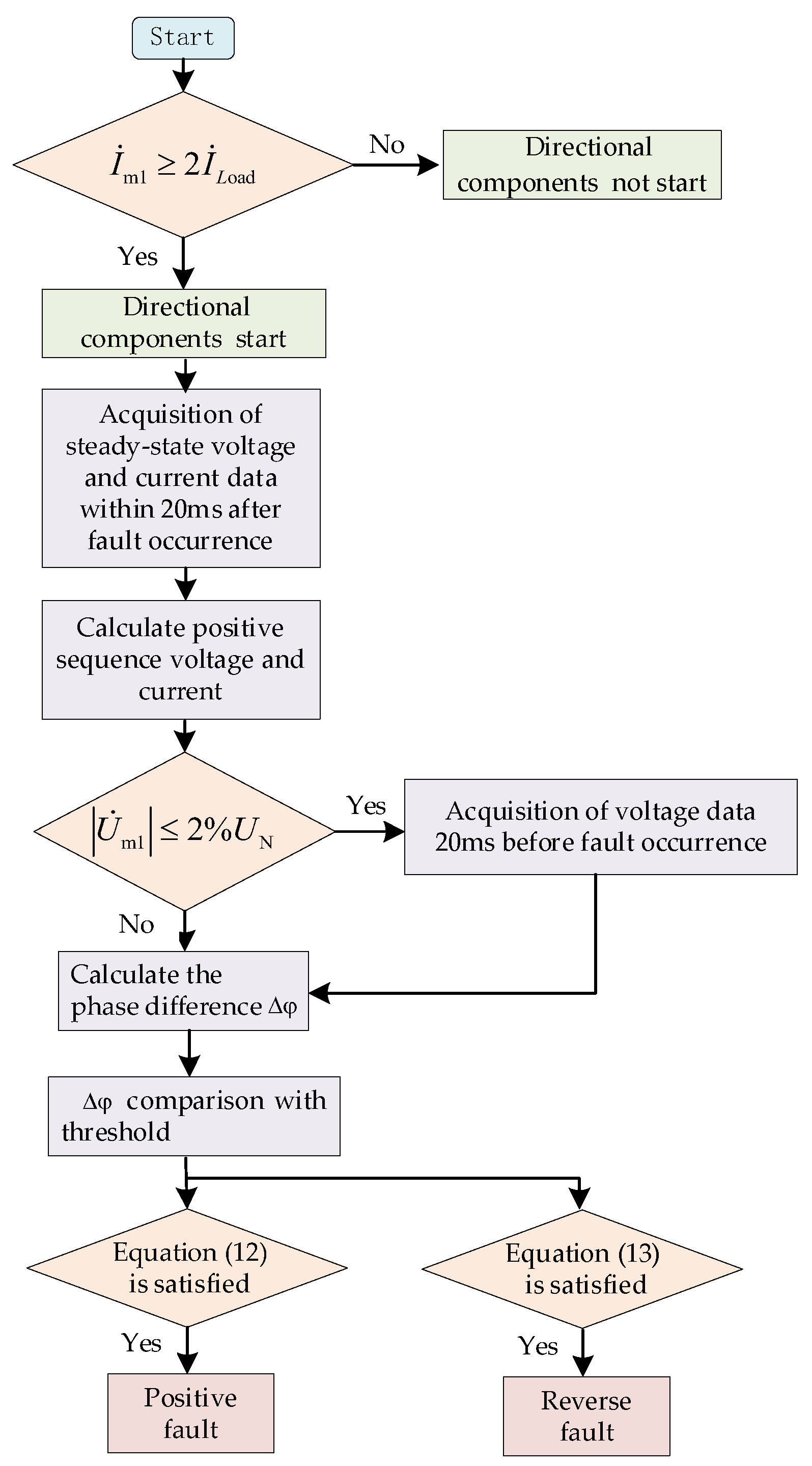

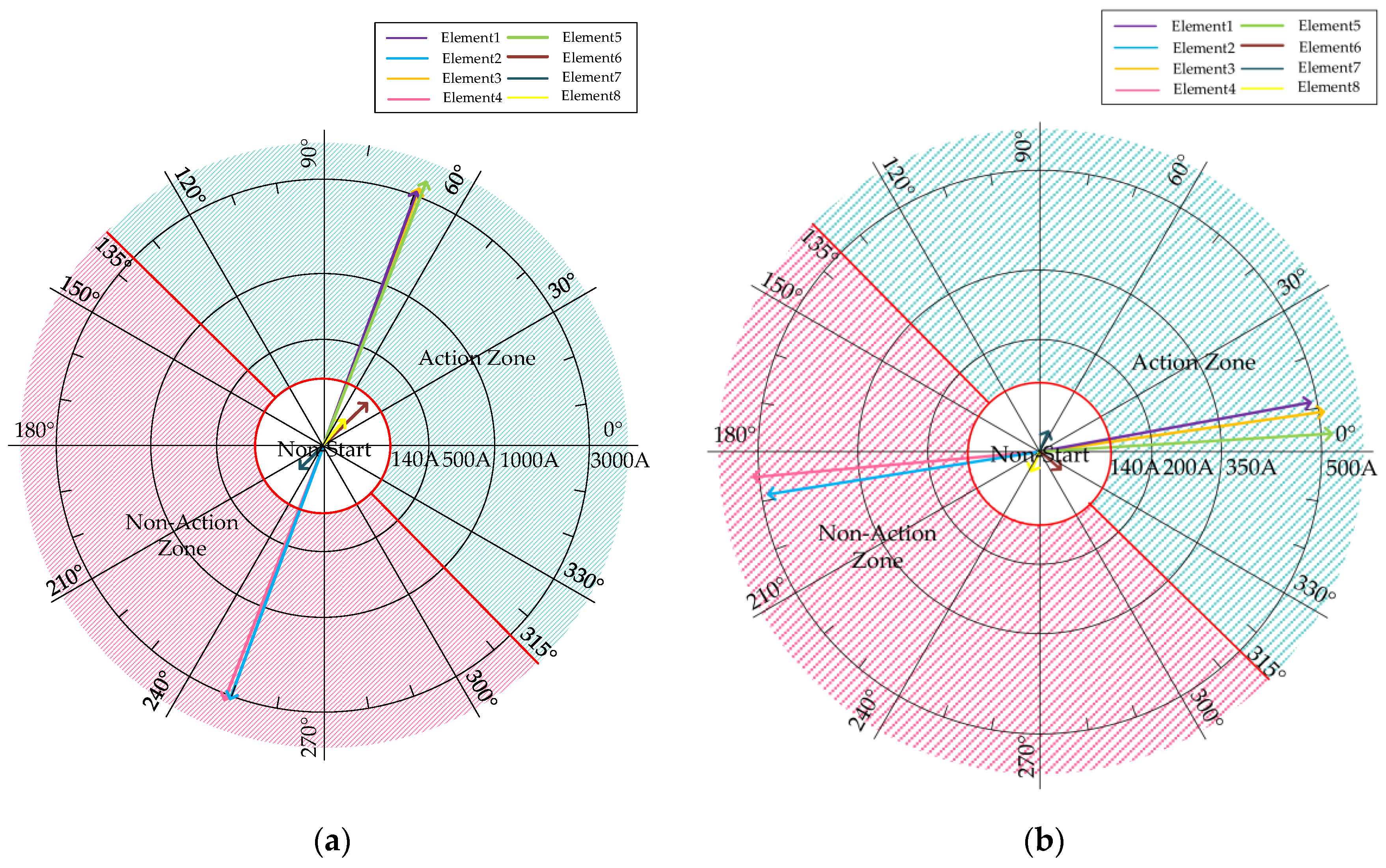
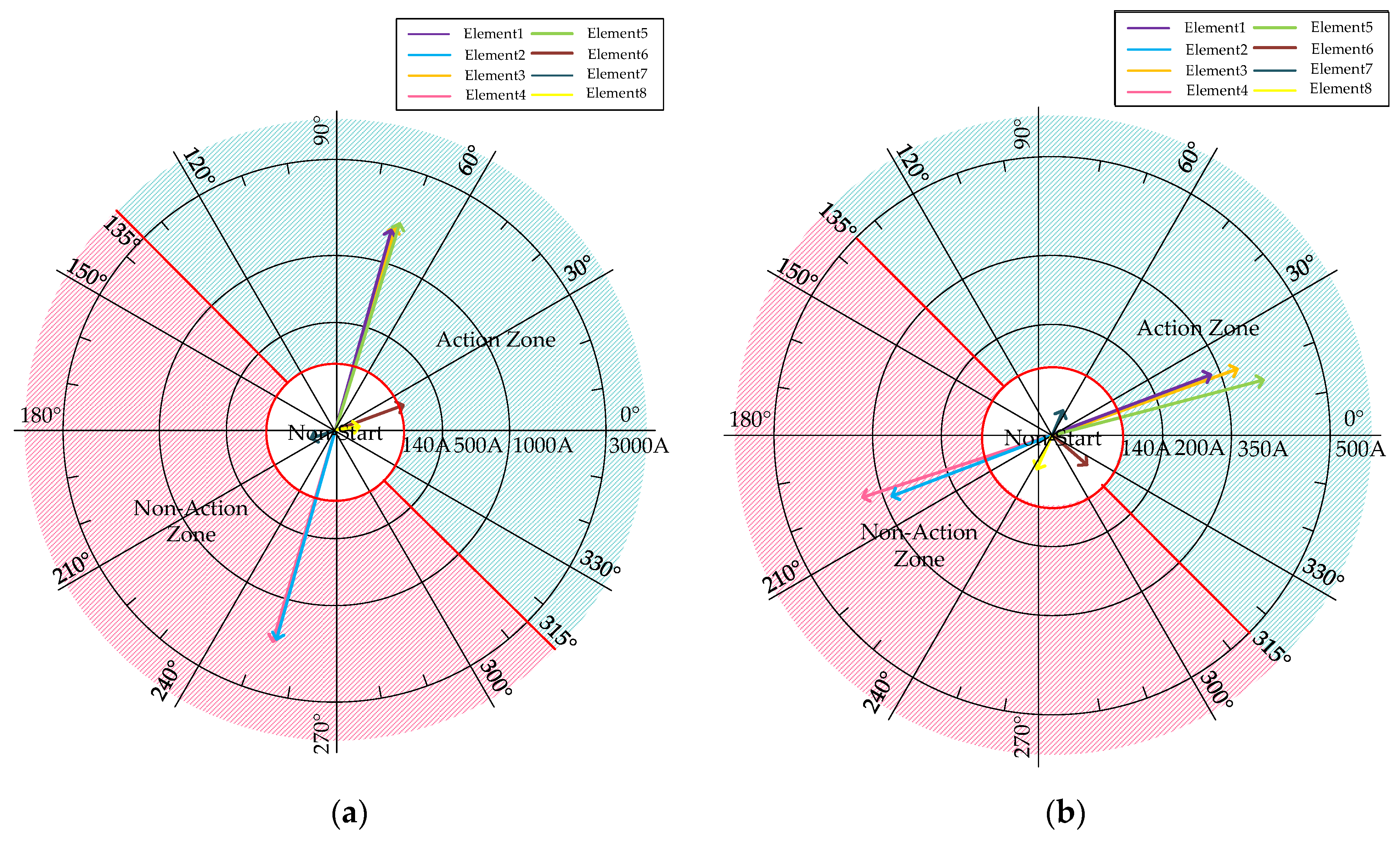

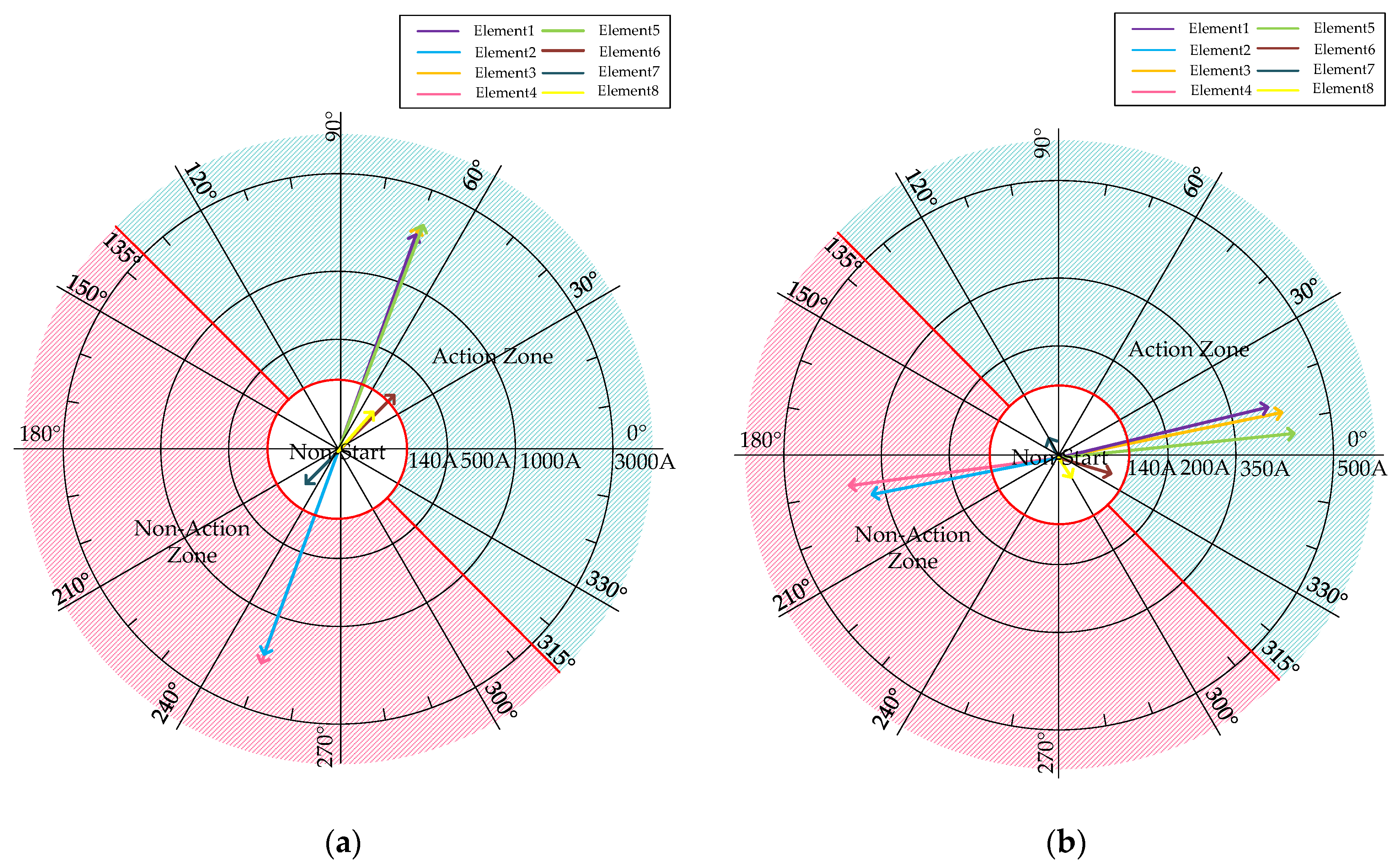
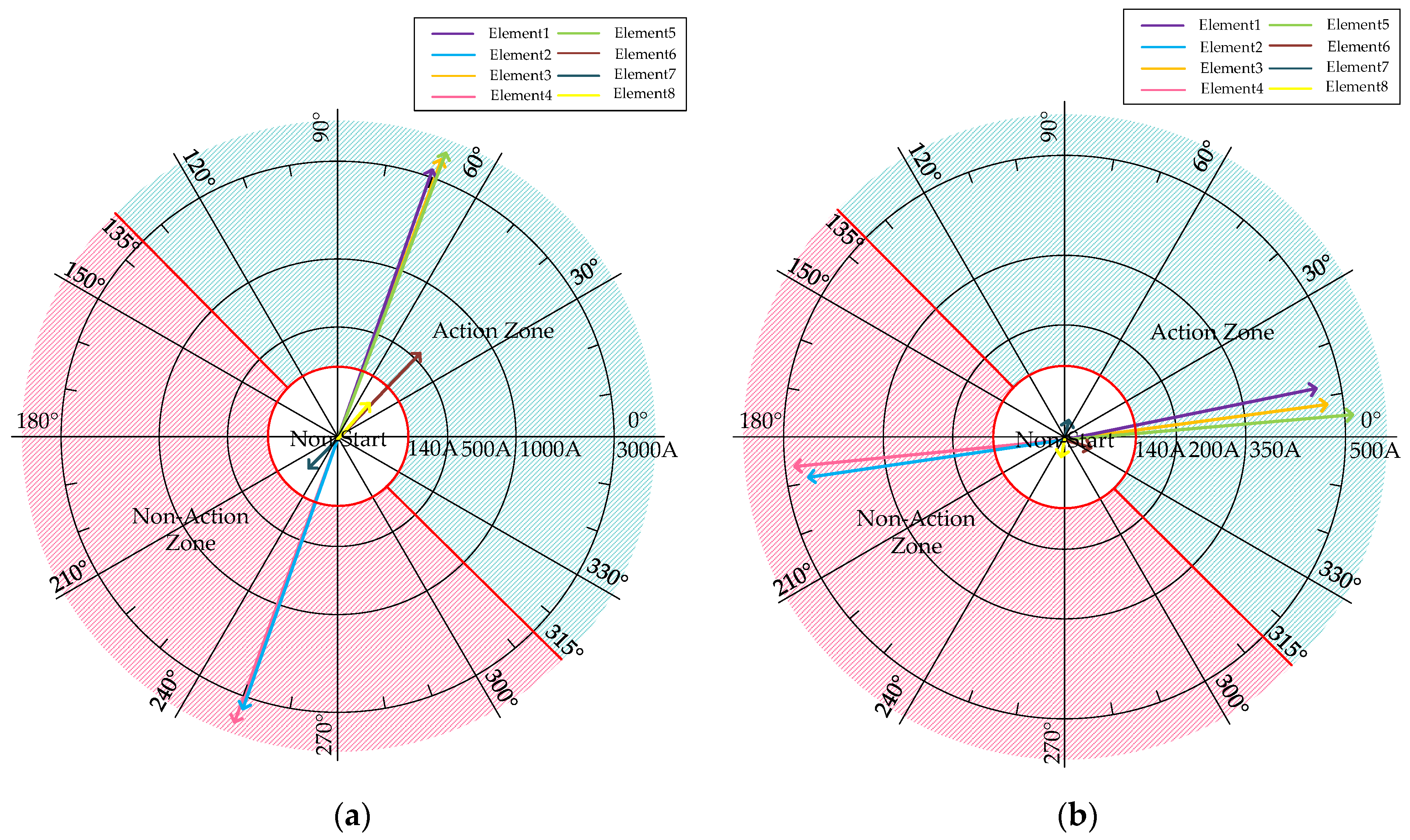

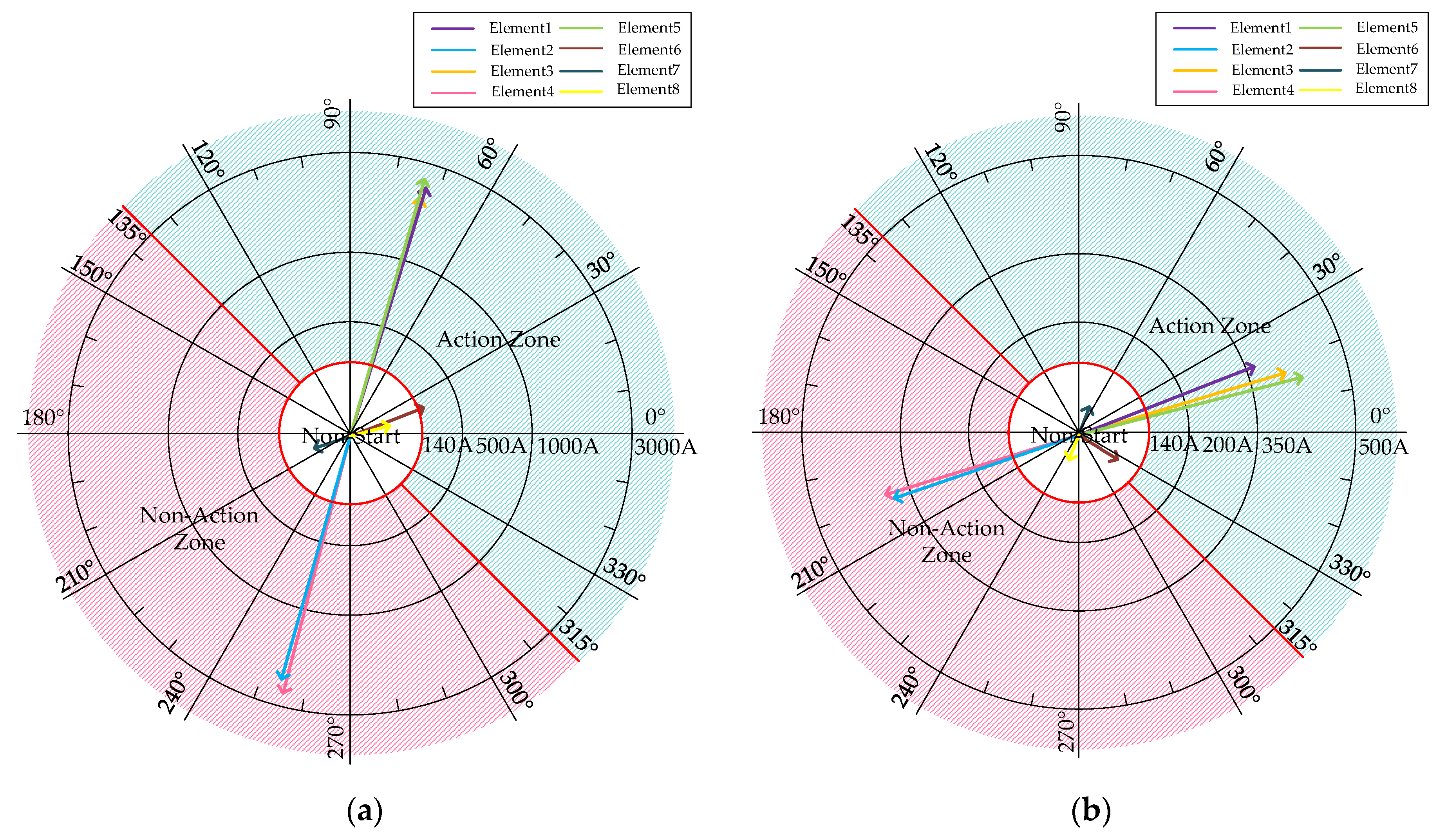
| Short Circuit Fault Type | Measured Value | 1 | 2 | 3 | 4 | 5 | 6 | 7 | 8 |
|---|---|---|---|---|---|---|---|---|---|
| Three-phase | −35° | 144° | −36° | 143° | −37° | −78° | 19° | 203° | |
| −35° | −216° | −36° | −217° | −37° | −78° | 19° | −156° | ||
| 325° | 144° | 324° | 143° | 323° | 282° | 19° | 203° | ||
| Phase-to-phase (BC) | 14° | 189° | 14° | 184° | 35° | −44° | −19.5° | 151° | |
| 317° | 142° | 322° | 147° | 327° | 267° | 48° | 229° |
| Short Circuit Fault Type | Measured Value | 1 | 2 | 3 | 4 | 5 | 6 | 7 | 8 |
|---|---|---|---|---|---|---|---|---|---|
| Three-phase | −113° | 54° | −126° | 51° | −130° | −138° | 54° | −126° | |
| Phase-to-phase (BC) | −115° | 53° | −127° | 51° | −129° | −141° | 62° | −118° |
| Fault Location | Transition Resistance | Measured Values and Actions of Directional Elements | 1 | 2 | 3 | 4 | 5 | 6 | 7 | 8 |
|---|---|---|---|---|---|---|---|---|---|---|
| Positive-sequence Voltage (V) | 5177 | 3708 | 3708 | 2253 | 2253 | 323 | 323 | 363 | ||
| Positive-sequence Current (A) | 1978 | 1979 | 1993 | 1994 | 2015 | 122 | 59 | 59 | ||
| Positive-sequence Impedance Angle (°) | 70 | −110 | 70 | −110 | 69 | 44 | −137 | 46 | ||
| Action of Directional Element | + | - | + | - | + | / | / | / | ||
| Positive-sequence Voltage (V) | 5737 | 5563 | 5563 | 5400 | 5400 | 5318 | 5318 | 5296 | ||
| Positive-sequence Current (A) | 463 | 463 | 481 | 481 | 500 | 43 | 30 | 31 | ||
| Positive-sequence Impedance Angle (°) | 12 | −172 | 82 | −175 | 5 | −39 | 65 | −114 | ||
| Action of Directional Element | + | - | + | - | + | / | / | / |
Disclaimer/Publisher’s Note: The statements, opinions and data contained in all publications are solely those of the individual author(s) and contributor(s) and not of MDPI and/or the editor(s). MDPI and/or the editor(s) disclaim responsibility for any injury to people or property resulting from any ideas, methods, instructions or products referred to in the content. |
© 2024 by the authors. Licensee MDPI, Basel, Switzerland. This article is an open access article distributed under the terms and conditions of the Creative Commons Attribution (CC BY) license (https://creativecommons.org/licenses/by/4.0/).
Share and Cite
Yang, F.; Chen, H.; Han, G.; Xu, H.; Lei, Y.; Hu, W.; Fan, S. A Fault Direction Criterion Based on Post-Fault Positive-Sequence Information for Inverter Interfaced Distributed Generators Multi-Point Grid-Connected System. Processes 2024, 12, 1522. https://doi.org/10.3390/pr12071522
Yang F, Chen H, Han G, Xu H, Lei Y, Hu W, Fan S. A Fault Direction Criterion Based on Post-Fault Positive-Sequence Information for Inverter Interfaced Distributed Generators Multi-Point Grid-Connected System. Processes. 2024; 12(7):1522. https://doi.org/10.3390/pr12071522
Chicago/Turabian StyleYang, Fan, Hechong Chen, Gang Han, Huiran Xu, Yang Lei, Wei Hu, and Shuxian Fan. 2024. "A Fault Direction Criterion Based on Post-Fault Positive-Sequence Information for Inverter Interfaced Distributed Generators Multi-Point Grid-Connected System" Processes 12, no. 7: 1522. https://doi.org/10.3390/pr12071522
APA StyleYang, F., Chen, H., Han, G., Xu, H., Lei, Y., Hu, W., & Fan, S. (2024). A Fault Direction Criterion Based on Post-Fault Positive-Sequence Information for Inverter Interfaced Distributed Generators Multi-Point Grid-Connected System. Processes, 12(7), 1522. https://doi.org/10.3390/pr12071522





